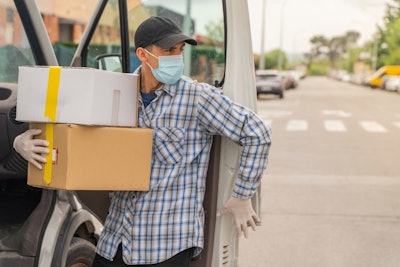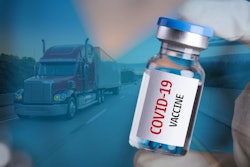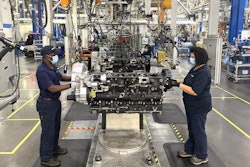
This week marks the one year anniversary of the coronavirus pandemic upending daily life for most Americans. COVID-19 was discovered earlier, originating and then exiting China in late 2019, but it wasn’t until the virus began wreaking havoc on America’s commercial and entertainment institutions that it became clear the nation wouldn’t be able to avoid COVID-19-related illness, chaos and destruction any longer.
A year later the battle against the virus remains ongoing, but with infection rates on the downswing nationwide and 23 percent of adults in the U.S. having already received at least one dose of the available COVID-19 vaccines, a light is finally visible at the end of the tunnel. COVID-19 won’t be eliminated by the end of this year, but its impact over most aspects of American life hopefully appears to be nearing its end.
In trucking’s dealer and aftermarket channels, COVID-19 has been a frustratingly unavoidable nuisance.
As an essential industry, dealers, distributors and service providers were forced to revolutionize their go-to-market strategies on the fly, developing practices to reduce virus transmission and ensure employee and customer safety without impacting customer service expectations or business effectiveness. Many never closed their doors to customers, instead limiting face-to-face interactions and capitalizing on technology to fight the complications of the pandemic.
But now, as states and communities begin to lift their restrictions on businesses, dealers and aftermarket operations face a new challenge: determining how much ‘back to normal’ is right for them.
“That’s the one thing I keep thinking about and am most concerned about as we come out of this. I don’t think it’s a switch we can flip and expect that everything will be normal again,” says Kevin Holmes, president, Advantage Truck Group (ATG). “We have to be cognizant of what our people have gone through and understand how they are recovering from this experience.”
Holmes says ATG is re-opening its six facilities to customers in stages. The dealer group chose to temporarily lockdown its stores — eliminating customer access to its building interiors — on more than one occasion during the pandemic due to high infection rates in its area of operation.
In each instance, Holmes says the first step in re-opening the facilities was providing customers limited access to its sales, parts and service departments. After a brief post-New Year’s Day lockdown, he says that’s the stage the company is in now. Barring any setbacks, Holmes says the company’s next step will be to expand the number of customers allowed into locations and provide them more freedom within its facilities.
Tim Schaffner says Cumberland Truck also plans to slowly ramp up its customer interactions over time. Cumberland Truck has kept its doors open and delivery trucks running every day through the pandemic, though it has enacted a number of policies to reduce direct contact between employees and customers.
Schaffner, the company’s director of parts sales, admits it has been difficult to socially distance employees who typically work in close quarters, such as office and warehouse staff, but also acknowledges it as a necessity to keep the business running as smoothly as possible.
With a two-week quarantine required for any employee potentially exposed to the virus, Schaffner says intra-facility social distancing has helped the company avoid any departmental slowdowns. “When you lose three or four people from your inner office, you don’t always have people waiting in the wings to take over for them,” he says.
At Four Star Freightliner, Dealer Principal Jerry Kocan says has prioritized sanitation and safety practices to enable the business to run as close to normal as possible. Like Cumberland Truck, Four Star has not closed its doors due to COVID-19, though it has required employees and customers to follow safety protocols and engage in social distancing throughout the business.
He says the practices have worked. Four Star has had very few virus issues across its six stores and no outbreak has led to a temporary shutdown of a store or department. Kocan says once health experts indicate PPE and social distancing no longer need to be prioritized he will consider updating the company’s safety procedures. But until then, he says the business will stick with what’s working.
Challenging as it has been, Kocan says the pandemic also has strengthened the relationship between Four Star and its employees and customers.
“I think it’s created this bond. We’re all in this together,” he says. “I know for our customers we’ve been able to show them we care about them and we want to keep them safe but we also want them to know they can still rely on us. That we are still here and will do what it takes to help them.”
Schaffner says he’s seen that too.
“Most every customer I’ve talked to understands what we’re doing and why we’re doing it,” he says. “I haven’t run into one person who didn’t appreciate that we are protecting our people and our customers.”
But that isn’t to say anyone is enjoying the ongoing situation. Holmes, Schaffner and Kocan all note it has been tough keeping employees physically and mentally healthy during the last year. Early safety measures were almost universally accepted last March because they were viewed at the time as temporary. One year later people want to be done with COVID-19 — even if it doesn’t feel the same.
“You can mobilize a group of people to a goal if you can show them how it will end. But two weeks to flatten the curve has now been 12 months,” says Kocan. “People want to know when this will end.”
Kocan says he’s doing his part to help Four Star employee morale by focusing on the light at the end of the tunnel. “There are a lot of positives out there. People are being smarter about how they do things. States are opening more and more and you’re not seeing as many spikes. We’re doing a lot more vaccinations … That’s what I keep pressing to my people. ‘Be safe. Don’t be careless. Eventually this too shall pass.’”
Holmes is doing the same.
“It’s encouraging to see things are getting better,” he says. “I think that gives people hope but I also think people — individuals themselves — are fragile right now. This has been hard. That’s why as this winds down we can’t just say ‘We’re back in business. Let’s go.’ We have to consider how to take that step.”










